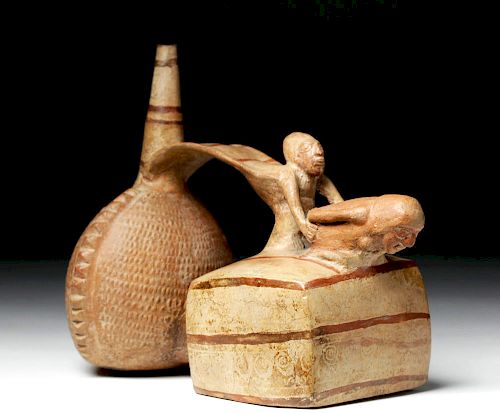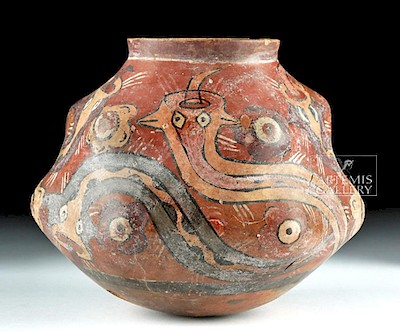Sican / Lambayeque Whistling Stirrup Jar - Erotic
Lot 158
About Seller
Artemis Gallery
686 S Taylor Ave, Ste 106
Louisville, CO 80027
United States
Selling antiquities, ancient and ethnographic art online since 1993, Artemis Gallery specializes in Classical Antiquities (Egyptian, Greek, Roman, Near Eastern), Asian, Pre-Columbian, African / Tribal / Oceanographic art. Our extensive inventory includes pottery, stone, metal, wood, glass and textil...Read more
Estimate:
$2,000 - $3,000
Absentee vs Live bid
Two ways to bid:
- Leave a max absentee bid and the platform will bid on your behalf up to your maximum bid during the live auction.
- Bid live during the auction and your bids will be submitted real-time to the auctioneer.
Bid Increments
| Price | Bid Increment |
|---|---|
| $0 | $25 |
| $300 | $50 |
| $1,000 | $100 |
| $2,000 | $250 |
| $5,000 | $500 |
| $10,000 | $1,000 |
| $20,000 | $2,500 |
| $50,000 | $5,000 |
| $100,000 | $10,000 |
| $200,000 | $20,000 |
About Auction
By Artemis Gallery
Jul 5, 2018
Set Reminder
2018-07-05 10:00:00
2018-07-05 10:00:00
America/New_York
Bidsquare
Bidsquare : Ancient | Ethnographic | Fine Art
https://www.bidsquare.com/auctions/artemis-gallery/ancient-ethnographic-fine-art-3306
Featuring classical antiquities, ancient and ethnographic art from cultures encompassing the globe. Artemis Gallery info@artemisgallery.com
Featuring classical antiquities, ancient and ethnographic art from cultures encompassing the globe. Artemis Gallery info@artemisgallery.com
- Lot Description
Pre-Columbian, northern Peru, Sican / Lambayeque culture, ca. 800 to 1000 CE. An explicitly erotic bi-chrome stirrup vessel , the form a twin lobed jar with a spiny spondylus shell at the rear section, and at the front end, connected via a bridge emerging from the male figure's back to the conical spout, an R-rated depiction of a couple engaged in the act of coitis, the male entering from the rear, his phallus clearly exposed, both atop a striped rectangular prism "cushion" with traces of a spiraled wave motif on the lower register. The whistle emerges from the head of the male and spout acts as the mouthpiece. Whistle works wonderfully! Size: 8.75" L x 4.875" W x 7.25" H (22.2 cm x 12.4 cm x 18.4 cm)
Spondylus shells, also known as spiny or thorny oysters for obvious reasons, have been revered by Andean peoples since the Pre-Columbian era. In addition to being featured in their artwork and used as currency, Spondylus pieces served as sacred offerings to Pachamama, the earth/time mother, a version of Mother Nature. The Spondylus shell carries numerous symbolic meanings. A symbol of fertility and elite social status, it was also believed to be an omen of rain, warning the indigenous of El Nino. In fact, the Spondylus shell only appears when the water becomes warmer during December - the time of the El Nino current - immediately before the rainy season.
Provenance: private Colorado Springs, Colorado USA collection
All items legal to buy/sell under U.S. Statute covering cultural patrimony Code 2600, CHAPTER 14, and are guaranteed to be as described or your money back.
A Certificate of Authenticity will accompany all winning bids.
We ship worldwide and handle all shipping in-house for your convenience.
#121461Spout reattached and bridge repaired with fissure running toward front section as shown. Nice traces of a spiraled wave motif on the lower register. Expected surface wear commensurate with age. Whistle works!Condition
- Shipping Info
-
All shipping is handled in-house for your convenience. Your invoice from Artemis Gallery will include shipping calculation instructions. If in doubt, please inquire BEFORE bidding for estimated shipping costs for individual items.
-
- Buyer's Premium



 EUR
EUR CAD
CAD AUD
AUD GBP
GBP MXN
MXN HKD
HKD CNY
CNY MYR
MYR SEK
SEK SGD
SGD CHF
CHF THB
THB

















